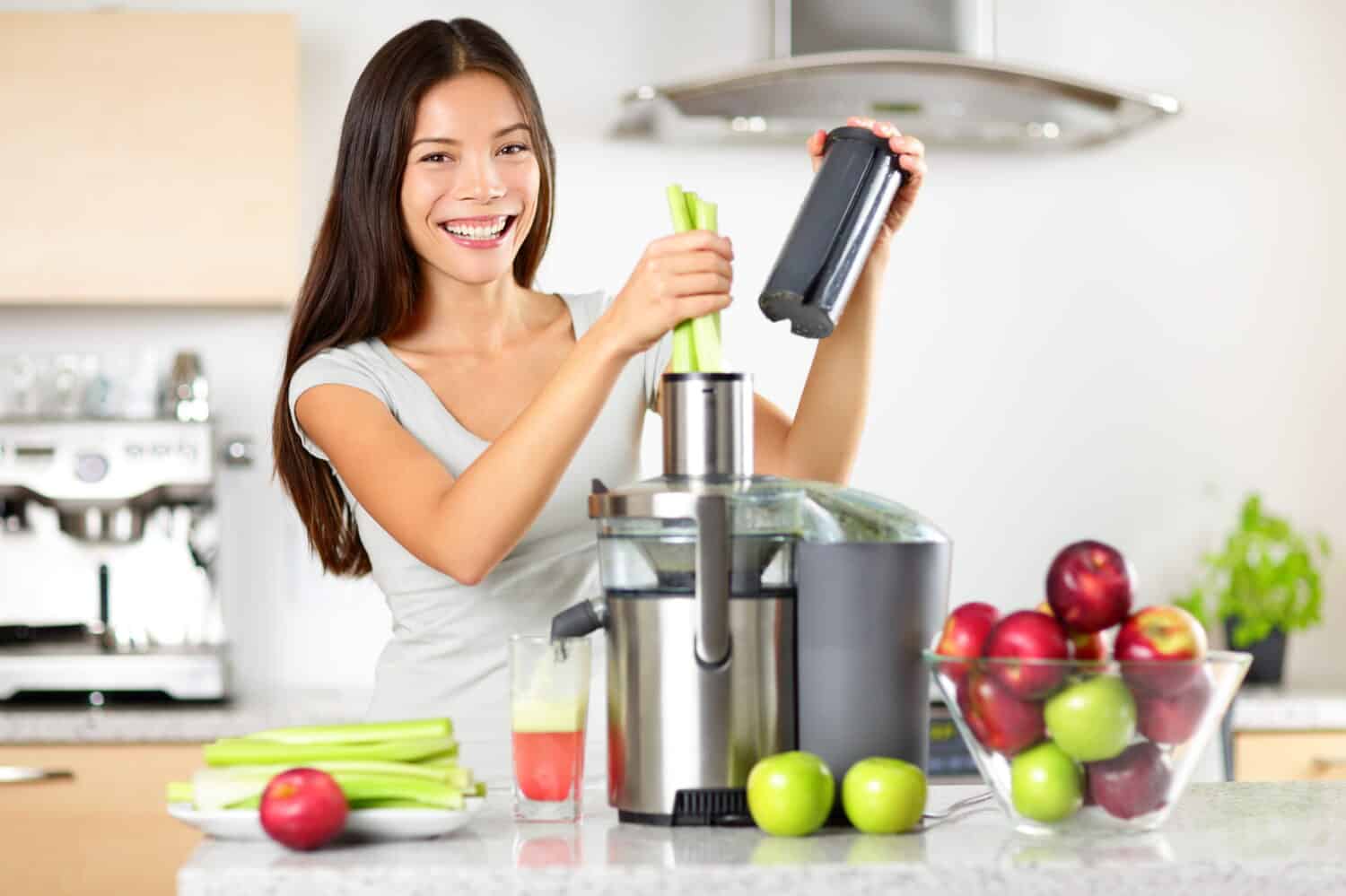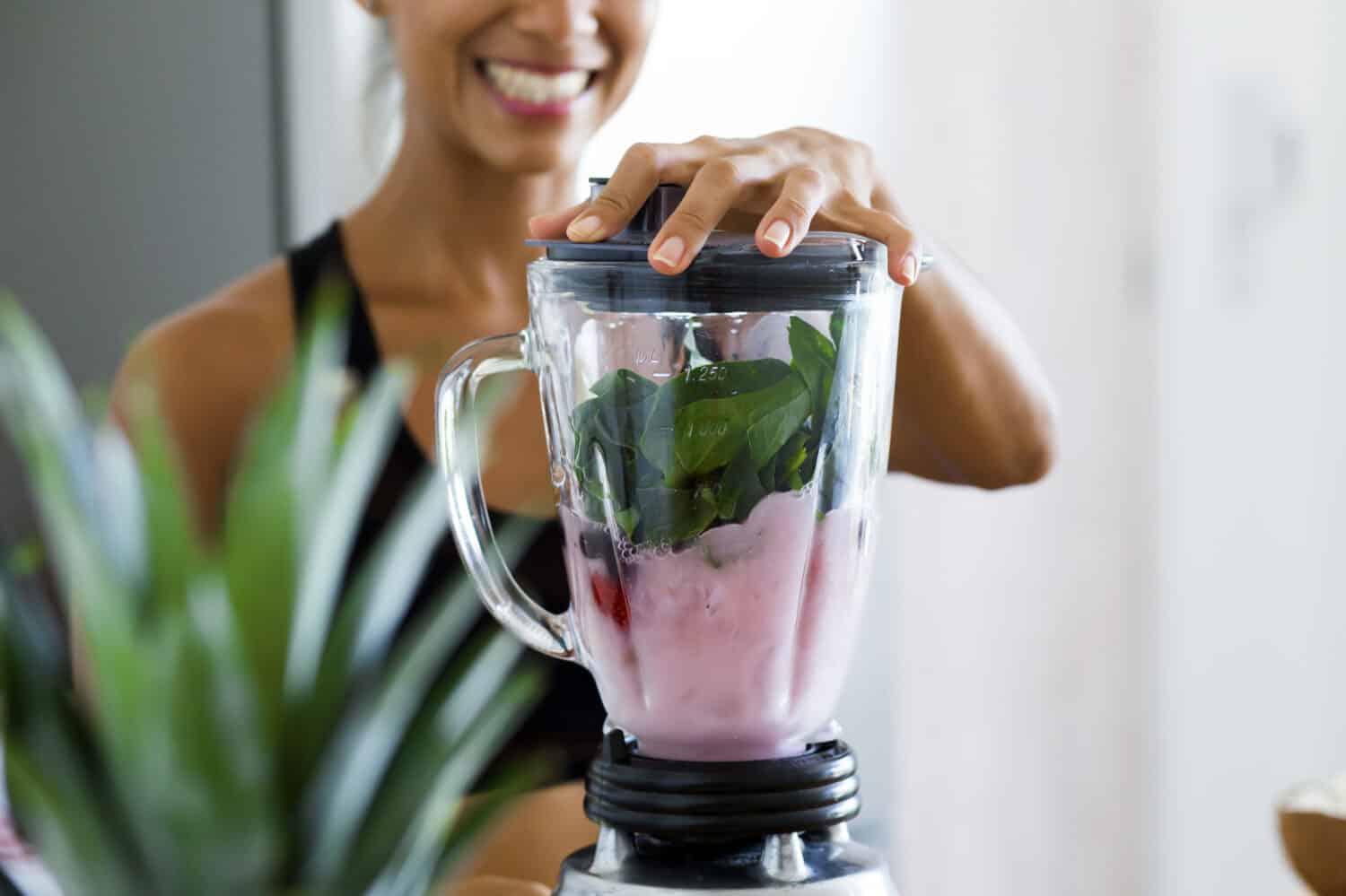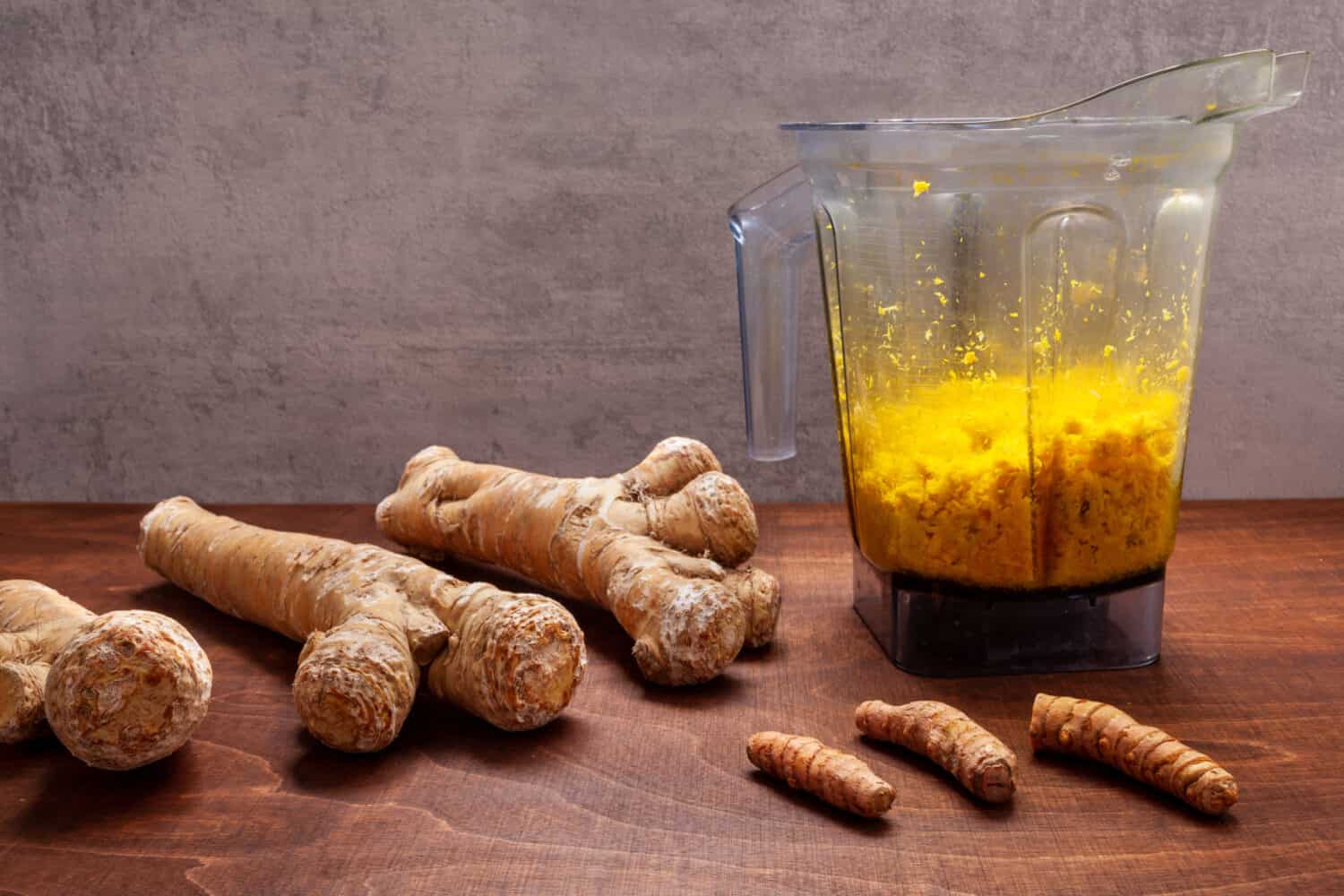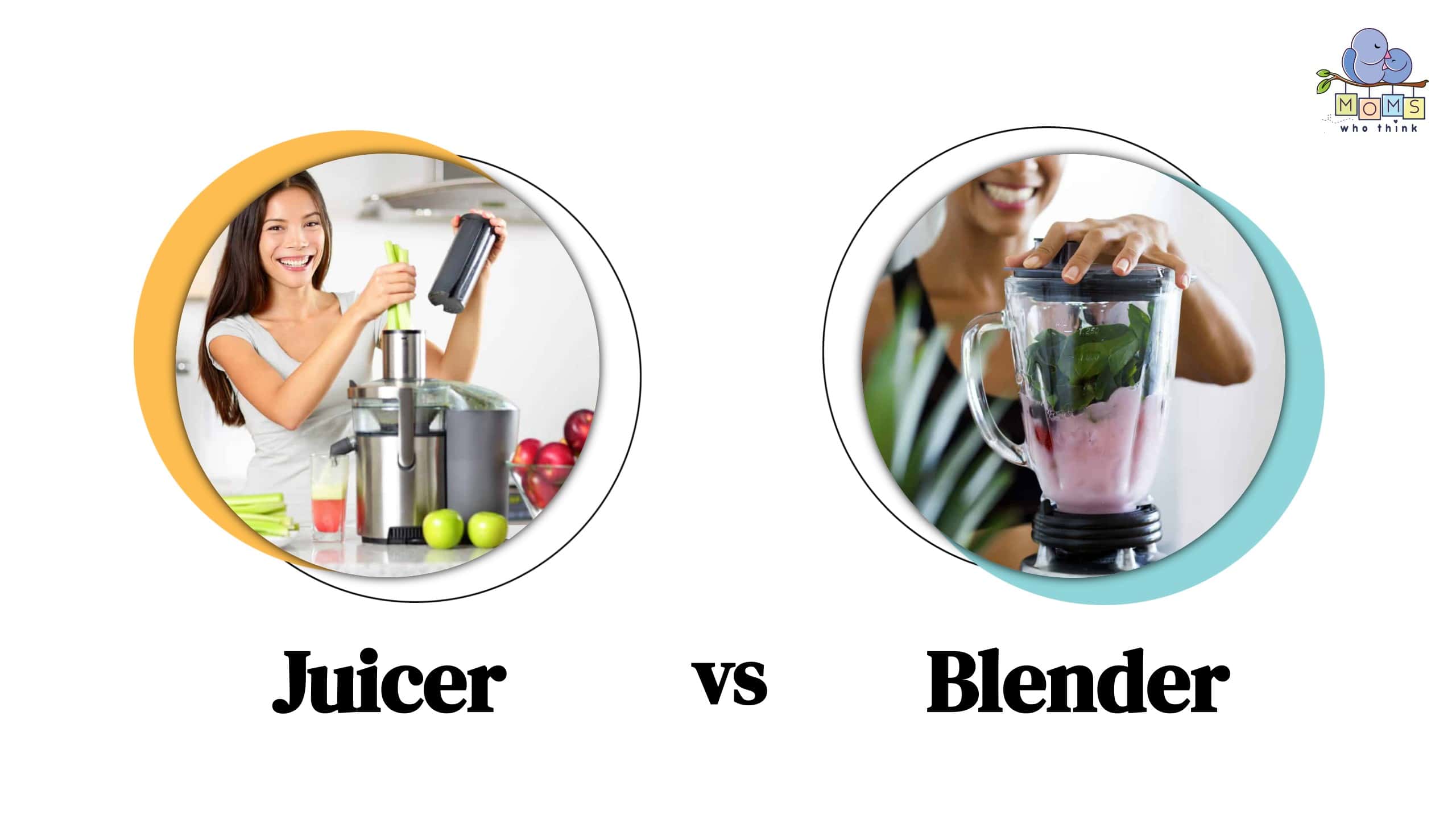While both a juicer and blender offer an opportunity for you to drink your way to better health, there are key differences. A juicer takes the juice out of fruits and veggies by extracting the juice and removing the skin, seeds, fiber and pulp. A blender, on the other hand, is more versatile and you retain the fiber because the whole fruit and veggies are blended together to make a thicker drink (think smoothie). But which is better for your health? What are the pros and cons of each? This article explores the key differences between a juicer vs. blender. Keep reading to see which one is the best for your family!
Juicer vs. Blender: Texture and Taste
Juicer
A juicer is a machine that extracts the juice from fruits and veggies and discards any skin and seeds as well as the fiber and pulp. This is done by squeezing, crushing, or grinding the fruits and veggies to get all of the liquid out or the juice. The end result is juice that is clear and smooth. And because of the pure liquid, it has a clean taste without any fibrous texture.

©Maridav/Shutterstock.com
Blender
A blender, on the other hand, is a machine that takes the entire fruit and/or vegetable and mixes everything together. And because a blender has sharp blades, the end result is you get a smooth mixture. It will also be thick because it retains the fiber from the fruits and vegetables.
Juicer vs. Blender: Cleaning and Waste
Juicers are machines designed to extract the liquid (juice) from fruits and vegetables. During this process, they separate the juice from the fibrous pulp, which is left behind as waste. The quantity of waste generated by juicers can vary, but it's primarily in the form of dry or slightly moist pulp, depending on the efficiency of the juicer and the type of fruits and vegetables you use.
On the flip side, as mentioned earlier, blenders work differently by blending all the ingredients such as fruits and veggies together. This includes the fiber. So when you think about it, that would mean blenders produce no waste such as leftover pulp like a juicer does. Why? Because everything is thoroughly blended into a single, thick mixture. So in essence you get to every part of the fruits and vegetables you use. That’s why it’s fair to say blenders are a zero waste option!

©Luna Vandoorne/Shutterstock.com
Juicer vs. Blender: Nutritional Value
Making juice from a juicer creates a strong concentration of vitamins and minerals. This is because the juicer separates the liquid from the fiber, making the nutrients easier for your body to absorb quickly. However, since the juicer extracts the liquid from the fruits and veggies, the juice doesn’t contain any fiber. Why is this important? Because juice from a juicer may not keep you feeling full for a long time. Plus the juice contains concentrated sugars from the fruits and veggies.
On the other hand, a blender keeps all the fiber from the fruits and veggies. Why is this important? Because fiber is essential for proper digestion, stabilizing blood sugar levels, and feeling satisfied or fuller longer, after eating or drinking. While blended drinks may have slightly fewer vitamins and minerals compared to juices, they are excellent for those who want both nutrition and a sense of fullness.
Juicer vs. Blender: Pros and Cons
Let’s first start with the pros of a juicer:
Juicers are good for people who want a quick way to enjoy just the juice without the chunky stuff and to get more nutrients in an easily digestible form. This works well especially if you don’t enjoy eating fruits and vegetables! It also offers the digestive system a break from processing fiber. Juicing has little to no fiber. And too much fiber isn’t good. Why? Because when you consume too much fiber – especially at one time – it can cause intestinal gas, abdominal bloating, and stomach cramping.
Another benefit to juicing is that it doesn't involve heat. That means most of the vitamins and minerals present in fruits and vegetables remain in the liquid. So you don’t lose the nutrients because of the heat causing it to evaporate. That’s great news, right? That means because the juice is cold-pressed, you get a more concentrated dose of these beneficial nutrients. And think about this: it’s a great way to get more of the benefits of eating fruits and veggies than you typically would in a day. Also, some will agree to various health benefits such as aiding in weight loss, detoxification, and better digestion.
Cons of a juicer:
- Loss of Fiber: When you juice, you miss out on the essential fiber in fruits and veggies. Fiber is your body's best friend for digestion, keeping you full and satisfied.
- High in Calories: Beware of the calorie trap! Juices can be sneaky calorie bombs, especially if you're using sugary fruits. Too much juice could be contributing to unwanted weight gain.
- Sugar Spikes: Natural doesn't always mean healthy. Fruit juices can pack a sugary punch, potentially causing rapid spikes in blood sugar levels. Why? Because all the sugar from fruits goes straight to your bloodstream.
- Cost Factor: Juicing can hit your wallet hard. Not only do you need to invest in a juicer, but buying fresh produce for juicing can become a costly habit.
- Wasted “goods”: Think about all that pulp you're tossing out. It's a waste of valuable nutrients and money.
- Cleaning and Maintenance: The hassle of cleaning a juicer with its multiple parts is enough to make you question the convenience of juicing.
- Limited Use: Juicers are one-trick ponies. That means they’re great at making juice, and nothing else.
- Oxidation Issues: Juice loses nutrients when it's exposed to air. So if you juice and leave it uncovered, it will oxidize – like how an apple cut open starts to turn brown – and start to lose its taste, color, and nutritional content.
- Storage: Storing juice is like a game of time. It loses flavor and nutrition quickly.

©Africa Studio/Shutterstock.com
Now let’s talk about the pros of a blender:
Blenders keep all the good stuff in the mix, like the fiber, which helps with digestion and makes you feel fuller longer. That’s great news because think about it this way: if you have a smoothie in the morning or afternoon, you don’t have to worry about a mid-morning or mid-afternoon energy crash. That means the chances of reaching for a candy bar or some other unhealthy snack are less because you have sustainable energy! Why?
Mainly because of the fiber you get from consuming whole fruits and veggies. There are two kinds of fiber that promote healthy digestion and overall well-being: soluble and insoluble.
- Soluble fiber is found in foods such as apples, bananas, pears, carrots, peas, green beans, and citrus fruits and berries like strawberries, blueberries, and raspberries. These dissolve in water and have the effect of slowing down digestion, which can help in maintaining stable blood sugar levels.
- On the other hand, insoluble fiber is found in vegetables such as cauliflower and dark leafy greens like kale, spinach, collards, and turnip greens. And guess what? Berries are a double benefit because they also contain insoluble fiber! Unlike soluble fiber, insoluble fiber doesn’t dissolve in water. Instead, they add more volume to your stool, encouraging your intestines to function efficiently.

©Fotema/Shutterstock.com
And you can use a blender in a variety of ways! For example, you can use it to make thick smoothies, soups, and sauces and to get all the nutrition from whole fruits and veggies.
Cons of a Blender
- Blending It Right: Blenders can be tricky with getting the right texture. For example, over-blending can turn a smoothie or sauce into a watery or overly smooth consistency. Some foods may become mushy or lose their original texture.
- Nutrient Loss: Blending can expose ingredients to oxygen and heat generated by the blender's motor. This can lead to the loss of key nutrients like vitamin C.
- It Can Be Noisy: Most blenders tend to be quite loud, which can be disruptive in a quiet environment, especially if you're making a smoothie early in the morning or late at night.
- Hard to Clean: Depending on the blender's design, cleaning it thoroughly can be a bit of a hassle, especially if it has many parts and hard-to-reach crevices.
- Cost Factor: High-quality blenders can be relatively expensive, which might be better for those on a tight budget.
Final Thoughts
So now that you understand the pros and cons and the key differences between a juicer vs. blender, which works best for your kitchen? Juicers extract pure liquid nutrition, leaving fiber behind for a quick nutrient boost, while blenders blend everything together, retaining fiber and promoting healthy digestion. Juicers excel in nutrient concentration, ideal for quick nutrient absorption, while blenders give you a nutritional balance leaving you with a full-feeling longer.
Whatever you choose, now you’ve got what you need to make a smart decision for optimal health!
Delicious Recipes Using a Blender
Tasty Recipes Using a Juicer
Not 1, nor 3, but 6 Ways to Juice for Better Health
